Friday, September 29, 2006
Cowden and the Godfrey Ancestors.
Cowden lies just across the border - just into Kent.
Bill's grandmother, Lousia Monk (nee Godfrey) was born in this parish in 1878. Her father, John was an agricultural labourer and he moved from farm to farm to find work. We don't know where he was in Cowden or how long he was there. It may not have been very long, for Louisa was the only one of his children to be born there and by the time she was three she was living in Quaker's Platt Lingfield/Dormansland.
Cowden is a small village and like many others has lost much of its rural past to the new upwardly mobile people who can now afford the old cottages. There is no shop there now and I believe the children travel to Edenbridge for their schooling. There is just one pub now, where there had been two.
The village has an interesting past, based on the local iron industry. There are some lovely cottages.
We had never been to the village before.

We parked the car at The Fountain.
We sat inside and enjoyed a drink and a packet of crisps. We might have ordered more to eat, but the menu was limited and they served smart meals at smart prices. We needed only a snack.
We wondered if John Godfrey, Bill's great grandfather had called in there some evenings. Perhaps on special days he might have taken his wife, Sophia carrying the baby Louisa in her arms.
It was good to imagine that we were supping ale where they might also have been.

We then walked through the quiet main street, enjoying the cottages.
The nearest would have been converted from the stables I think. The steps outside would have been used for getting onto a horse without the need to heave oneself up - very useful for an older person. The edge of the top stone was well worn down by feet at the edge.
You can see from the watery pale sky that we were not enjoying the best of weather.

The church is dedicated to St. Mary Magdalene.
The original 12th century building was replaced in the 14th century.
The tower and spire are considered to be unique, covered with wooden shingle tiles.
There is a rhyme about the spire of Cowden church:
Cowden church, crooked steeple,
Lying priest, deceitful people.
The second line is thought to reflect the opinions of those in the neighbouring parish of Hartfield over its defeat in a dispute with Cowden about the settlement of a pauper.

This picture looking towards the bell tower (with the altar behind us) shows well the simple old constuction.
The church has a good set of bells and the bell ringers have won competitions.

The font.
We can assume that Grandmother Lousia was baptised at this font.
The guide book which we bought, tells us that the font is in a medieval style. The writer surmises that an exact replica was substituted towards the end of the 19th century.
Perhaps Louisa was given her name at the earlier example.

We walked around the churchyard - three separate fields.
There were no expectations of finding family laid to rest there.
So we just wandered.
I liked this stone aganst the autumns reds of the virginia creeper.
Yes, I know its a bit tilted!

I liked the view of the cottages from the church yard.

The Old Forge - a link with the medieval iron industry past.
It is now a dwelling of course.
So, we enjoyed just a brief trip to Cowden. Don't forget it is pronounced Cow-Denne. I had told Bill that, but still Cowdun slipped out when we were chatting in the post office in Dormansland. It was quickly pointed out that he had got it wrong.
Lousia would have had no memories of the place - having left there before she was 3 years old.
And I expect John and Sophia were glad to get away - back the 4 or 5 miles to Dormansland, part of Lingfield. They had both been born in Lingfield and their parents would have been quite close by.
Bill's grandmother, Lousia Monk (nee Godfrey) was born in this parish in 1878. Her father, John was an agricultural labourer and he moved from farm to farm to find work. We don't know where he was in Cowden or how long he was there. It may not have been very long, for Louisa was the only one of his children to be born there and by the time she was three she was living in Quaker's Platt Lingfield/Dormansland.
Cowden is a small village and like many others has lost much of its rural past to the new upwardly mobile people who can now afford the old cottages. There is no shop there now and I believe the children travel to Edenbridge for their schooling. There is just one pub now, where there had been two.
The village has an interesting past, based on the local iron industry. There are some lovely cottages.
We had never been to the village before.

We parked the car at The Fountain.
We sat inside and enjoyed a drink and a packet of crisps. We might have ordered more to eat, but the menu was limited and they served smart meals at smart prices. We needed only a snack.
We wondered if John Godfrey, Bill's great grandfather had called in there some evenings. Perhaps on special days he might have taken his wife, Sophia carrying the baby Louisa in her arms.
It was good to imagine that we were supping ale where they might also have been.

We then walked through the quiet main street, enjoying the cottages.
The nearest would have been converted from the stables I think. The steps outside would have been used for getting onto a horse without the need to heave oneself up - very useful for an older person. The edge of the top stone was well worn down by feet at the edge.
You can see from the watery pale sky that we were not enjoying the best of weather.

The church is dedicated to St. Mary Magdalene.
The original 12th century building was replaced in the 14th century.
The tower and spire are considered to be unique, covered with wooden shingle tiles.
There is a rhyme about the spire of Cowden church:
Cowden church, crooked steeple,
Lying priest, deceitful people.
The second line is thought to reflect the opinions of those in the neighbouring parish of Hartfield over its defeat in a dispute with Cowden about the settlement of a pauper.

This picture looking towards the bell tower (with the altar behind us) shows well the simple old constuction.
The church has a good set of bells and the bell ringers have won competitions.

The font.
We can assume that Grandmother Lousia was baptised at this font.
The guide book which we bought, tells us that the font is in a medieval style. The writer surmises that an exact replica was substituted towards the end of the 19th century.
Perhaps Louisa was given her name at the earlier example.

We walked around the churchyard - three separate fields.
There were no expectations of finding family laid to rest there.
So we just wandered.
I liked this stone aganst the autumns reds of the virginia creeper.
Yes, I know its a bit tilted!

I liked the view of the cottages from the church yard.

The Old Forge - a link with the medieval iron industry past.
It is now a dwelling of course.
So, we enjoyed just a brief trip to Cowden. Don't forget it is pronounced Cow-Denne. I had told Bill that, but still Cowdun slipped out when we were chatting in the post office in Dormansland. It was quickly pointed out that he had got it wrong.
Lousia would have had no memories of the place - having left there before she was 3 years old.
And I expect John and Sophia were glad to get away - back the 4 or 5 miles to Dormansland, part of Lingfield. They had both been born in Lingfield and their parents would have been quite close by.
Thursday, September 28, 2006
Dormansland and the Ancestors.
DORMANSLAND......
For all my life Dormansland has been a hazy notion.
When I was a child I would scramble off the bus outside The White Hart in Crawley and might see the 434 bus waiting there to proceed on its journey. The destination shown by the number was Dormansland. I didn't know anybody who had ever been there and yet there was a special bus to go there. I didn't know where it was and it sounded strangely foreign.
Little did I know that much later in life I would find strong links with the place.
The first time I discovered those links they were still very hazy.
Long before I attempted some more serious genealogy there had been some interest in the ancestors. I remember asking Bill's Father about his childhood and his aunts and uncles.
It was the first time I had heard of Bill's Great Aunt Jane.
All Dad could tell me was that Aunt Jane had married a Mr. Chapman and gone to live in Dormansland. He would have seen her very rarely, but he could recall that she came to visit the family back in Charlwood sometimes. She pedalled over on her bike, a distance of 15 miles or so. By the time she arrived back in Charlwood she might have been a little intoxicated having paused on her journey to refresh herself from the hip flask she carried.
I sensed that Dad found her strangely fascinating.
When I began the genealogy project we had very early on a magical moment when, through the wonders of the internet, I found myself in correspondence with Joyce in Canada - Jane's grand daughter. It was wonderful and Joyce filled in many details about Bill's Great Aunt.
Gradually I learned how to find more information.
I discovered that Bill's grandmother (Jane's sister in law) came from the next village, Lingfield.
In 1881 she, Louisa, was a 3 year old living in Quaker's Platt.
Later I was working on Bill's mother's side of the family and I found George and Annie Brand, Bill's great grandparents living in Quaker's Platt.
It seemed amazing that these 2 branches of the family who were not living close together in the late 1930s when Bill's parents met and married had been living in the same street in 1881.
And even more amazing was the fact that we discovered that Quaker's Platt was not actually in Lingfield, but in Dormansland!
Today we have actually been to explore this great centre of Bill's family life just a little. I think we shall need to go back.
The village of Dormansland has almost lost its identity in recent years because it is now a settlement for people who work in businesses elsewhere. There are few rural pursuits anymore. And yet it is still a village, separate from the much bigger, bustling East Grinstead and a community spirit of a different kind has evolved.
When the the ancestors were there in 1881 there was very little development. Quakers Platt was open heath land on the side of a hill and I would guess the housing there was mainly shabby wooden constructions. There was little else to be seen.
The church had not yet been built, but followed during the 1880s, along with a school and other amenities.
Development followed quite rapidly as the railway made it possible, even then for Dormansland to be a commuter town. There was a station.
Today, it is very different. The area known as Quaker's Platt exists and there are the normal range of houses there, built mostly since the second world war, with a few older cottages dotted between.
 First, we stopped at the parish Church of St. John.
First, we stopped at the parish Church of St. John.
Walking through the wooden lych gate we saw the war memorial.
We already had evidence from Joyce in Canada that a family name would be there.
Great Aunt Jane's first born, William died in 1918.

We see here that he died of a sickness.
We know he left a young widow, Florence.
We spent a while wandering amongst the grave stones, which are always interesting.

Suddenly we found a stone for Great Aunt Jane's last born son, Cecil.
He died in the 1960s. His wife, Doris survived him for another 10 years or so.
We don't know who Jack Skelton is - but Doris's maiden name was Skelton and so he is clearly connected in some way.

We then moved away from glimpses into the Chapman past and on to Quaker's Platt. The road into this part is just now known as The Platt.
Now we were stepping back into the lives of Bill's grandmother and the Godfrey family and also Bill's great grandparents George and Annie Brand.
I wonder if either of those families noticed the arrival of the young couple Jane and William Chapman, though we don't know exactly which part they were living in at that time.

I have included this lovely cottage, because it is one of the few that remain from earlier times.
I doubt whether any of the ancestors lived in a cottage as large as this. But Louisa, George and Annie would have passed this cottage many a time.

This is an example of a more modern house. I have included it because we are sure it is where Joyce, from Canada, stayed when she visited in the 1970s.
So, I imagine at that time a Chapman was living along the Platt.

The Old House at Home - a lovely name for an old pub.
I think we can be sure that many of the ancestors would have known about this building.
We stopped and talked for quite a while with a local resident who was out in her garden. She felt she had been in Dormansland for a long time - 44 years, but she had no knowledge of any Chapmans.
We called in at the post office to ask a few question.
Nobody knew of a Cowden Lodge, which we believed was Jane's home at the end of her life. It was suggested that we went to Cowden to ask - which we did, but that's another story.
And a relevant story because we know that Louisa, Bill's grandmother was
born in Cowden.
Pronounced please COW _ DENNE.
We stayed quite a while in the post office. The lady there was keen to talk and customers who came in joined the conversation and added all sorts of bits and pieces. One man was almost sure that the bearded lady who ran the pub on the way to Balls Cross was still there. She only ever served wine and light ale, and if you were very hungry she would find you a bit of bread and cheese.
So that was our short visit to Dormansland. I feel sure that we will need to go back again to check more things out.
For all my life Dormansland has been a hazy notion.
When I was a child I would scramble off the bus outside The White Hart in Crawley and might see the 434 bus waiting there to proceed on its journey. The destination shown by the number was Dormansland. I didn't know anybody who had ever been there and yet there was a special bus to go there. I didn't know where it was and it sounded strangely foreign.
Little did I know that much later in life I would find strong links with the place.
The first time I discovered those links they were still very hazy.
Long before I attempted some more serious genealogy there had been some interest in the ancestors. I remember asking Bill's Father about his childhood and his aunts and uncles.
It was the first time I had heard of Bill's Great Aunt Jane.
All Dad could tell me was that Aunt Jane had married a Mr. Chapman and gone to live in Dormansland. He would have seen her very rarely, but he could recall that she came to visit the family back in Charlwood sometimes. She pedalled over on her bike, a distance of 15 miles or so. By the time she arrived back in Charlwood she might have been a little intoxicated having paused on her journey to refresh herself from the hip flask she carried.
I sensed that Dad found her strangely fascinating.
When I began the genealogy project we had very early on a magical moment when, through the wonders of the internet, I found myself in correspondence with Joyce in Canada - Jane's grand daughter. It was wonderful and Joyce filled in many details about Bill's Great Aunt.
Gradually I learned how to find more information.
I discovered that Bill's grandmother (Jane's sister in law) came from the next village, Lingfield.
In 1881 she, Louisa, was a 3 year old living in Quaker's Platt.
Later I was working on Bill's mother's side of the family and I found George and Annie Brand, Bill's great grandparents living in Quaker's Platt.
It seemed amazing that these 2 branches of the family who were not living close together in the late 1930s when Bill's parents met and married had been living in the same street in 1881.
And even more amazing was the fact that we discovered that Quaker's Platt was not actually in Lingfield, but in Dormansland!
Today we have actually been to explore this great centre of Bill's family life just a little. I think we shall need to go back.
The village of Dormansland has almost lost its identity in recent years because it is now a settlement for people who work in businesses elsewhere. There are few rural pursuits anymore. And yet it is still a village, separate from the much bigger, bustling East Grinstead and a community spirit of a different kind has evolved.
When the the ancestors were there in 1881 there was very little development. Quakers Platt was open heath land on the side of a hill and I would guess the housing there was mainly shabby wooden constructions. There was little else to be seen.
The church had not yet been built, but followed during the 1880s, along with a school and other amenities.
Development followed quite rapidly as the railway made it possible, even then for Dormansland to be a commuter town. There was a station.
Today, it is very different. The area known as Quaker's Platt exists and there are the normal range of houses there, built mostly since the second world war, with a few older cottages dotted between.
 First, we stopped at the parish Church of St. John.
First, we stopped at the parish Church of St. John.Walking through the wooden lych gate we saw the war memorial.
We already had evidence from Joyce in Canada that a family name would be there.
Great Aunt Jane's first born, William died in 1918.

We see here that he died of a sickness.
We know he left a young widow, Florence.
We spent a while wandering amongst the grave stones, which are always interesting.

Suddenly we found a stone for Great Aunt Jane's last born son, Cecil.
He died in the 1960s. His wife, Doris survived him for another 10 years or so.
We don't know who Jack Skelton is - but Doris's maiden name was Skelton and so he is clearly connected in some way.

We then moved away from glimpses into the Chapman past and on to Quaker's Platt. The road into this part is just now known as The Platt.
Now we were stepping back into the lives of Bill's grandmother and the Godfrey family and also Bill's great grandparents George and Annie Brand.
I wonder if either of those families noticed the arrival of the young couple Jane and William Chapman, though we don't know exactly which part they were living in at that time.

I have included this lovely cottage, because it is one of the few that remain from earlier times.
I doubt whether any of the ancestors lived in a cottage as large as this. But Louisa, George and Annie would have passed this cottage many a time.

This is an example of a more modern house. I have included it because we are sure it is where Joyce, from Canada, stayed when she visited in the 1970s.
So, I imagine at that time a Chapman was living along the Platt.

The Old House at Home - a lovely name for an old pub.
I think we can be sure that many of the ancestors would have known about this building.
We stopped and talked for quite a while with a local resident who was out in her garden. She felt she had been in Dormansland for a long time - 44 years, but she had no knowledge of any Chapmans.

We called in at the post office to ask a few question.
Nobody knew of a Cowden Lodge, which we believed was Jane's home at the end of her life. It was suggested that we went to Cowden to ask - which we did, but that's another story.
And a relevant story because we know that Louisa, Bill's grandmother was
born in Cowden.
Pronounced please COW _ DENNE.
We stayed quite a while in the post office. The lady there was keen to talk and customers who came in joined the conversation and added all sorts of bits and pieces. One man was almost sure that the bearded lady who ran the pub on the way to Balls Cross was still there. She only ever served wine and light ale, and if you were very hungry she would find you a bit of bread and cheese.
So that was our short visit to Dormansland. I feel sure that we will need to go back again to check more things out.
Monday, September 04, 2006
CHARLWOOD PATHWAYS AND ANCESTORS
Charlwood was always somewhere to go to when I was a child. There was a circular route, via Ifield Wood and back along Bonnets Lane which we regularly seemed to cycle round. It was about a 5 mile round trip. I don't remember actually doing anything in Charlwood.
I went there far more often than Bill did and yet he had family there.
His father had grown up there and there had been Monks in the village for a couple of hundred years. Later research has shown that ancestors on his mother's side were also in Charlwood in the 19th century.
Bill's grandparents died during the war. His father returned home from a prisoner of war camp after hostilities ceased to pick up the pieces of his life with a wife and a young son in Crawley. He felt no need to go back to Charlwood, though he had cousins there.
Bill and I pass through the village often. Sometimes we have stopped to absorb some village atmosphere and imagine how things were for the earlier Monks.
His grandparents would hardly recognise the place - though lots of old houses and cottages remain.
With the growth of both Crawley and Gatwick, Charlwood has also grown. One can find architectural syles from the 1950s and 1960s and on to the end of the 1990s. The development of housing has slowed now for fear of more extensive plans taking shape. Gatwick Airport has reached saturation point with one runway, and for 20 years or so there has been talk of a second runway.
We are led to believe that the plans have been shelved - for now. If the second runway were to be built it would further spoil what was once a rural idyll.
Today we went for a walk across the land that would be lost to airport development. The views across the fields were peaceful and rural, but our walk was punctuated by the roar of aeroplanes taking off about 2 miles away. Bill didn't seem to mind and commented that it was a good place for aeroplane spotting.

We parked the car near to the church. His grandparents were buried here - and presumably many other relations. But apparently many old and decrepid stones were moved. We must arrange some time to discover exactly where William and Louisa were laid to rest.
After a while our walk across the fields brought us to a crossroads - a signpost pointed to footpaths in all 4 directions and there was a map on the post.
We turned right, back towards the village.
Our aim was to find Providence Chapel. We had missed it last time we walked in the village, although we had walked to the end of Chapel Lane, or so we thought.
We know that some members of the Monk family had been chapel people.
Today we found the chapel and it was not what we expected.
Chapels are normally brick built with some high pointed windows, but Providence Chapel was a wood clad building.
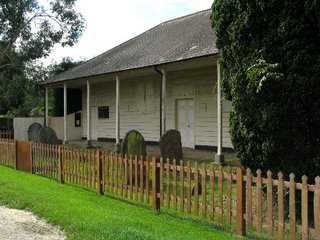
The sign on the wall stated that the chapel was built in 1816.
The fence round it is obviously much more recent.
The road in front of the chapel is not a made up road - more like a farm track.

The very first grave we saw belonged to the family.
You might just be able to make out the name William Monk.
This William was not Bill's grandfather (who we believe lies in the churchyard). This William was Bill's grandfather's cousin and therefore is Bill's first cousin twice removed. William was married to Charlotte and she was also buried here. William died in 1923 and Charlotte lived on until 1943.
We have followed the lives of William and Charlotte. They spent their early married lives at Sussex Farms. We found one of them, Corts Farm, down near Midhurst. In 1901 they at at Racton Entire, the other side of Chichester.
At some point after that they returned to Charlwood. Their daughter, Nellie had gone back earlier and in 1901 was a teacher at the village school and lived with her Grandfather.
When they returned to Charlwood, William and Charlotte lived in Elm House - a very short distance from Fulbrooks Farm, where Great Uncle John and his wife Susan lived with their family. Tucked in between these 2 houses was the rather shabby little home which was called The Nest, where Bill's grandparents lived.
Great Uncle John and Susan were also chapel people - but we found no grave for them.

William and Charlotte's grave is the dark grey stone just inside the gate on the left.
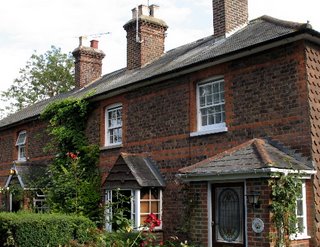 Just a little further along Chapel Lane are the 3 Providence Cottages. We know that Bill's great grandfather lived in one of them towards the end of his life - indeed we have it down that he died here in 1915.
Just a little further along Chapel Lane are the 3 Providence Cottages. We know that Bill's great grandfather lived in one of them towards the end of his life - indeed we have it down that he died here in 1915.
In 1901 he was in Rosemary Cottage, which we also passed.
 I can't tell you if any ancestors spent any time in this building - the village lock up, or cage.
I can't tell you if any ancestors spent any time in this building - the village lock up, or cage.
I have discovered no tales of dastardly deeds.
But a certain George Monk was reprimanded by the Horley powers that be for leading a life unsuitable for a family man!

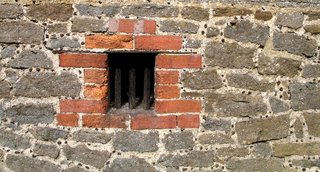
It is only a very small square room inside and these windows would have given very little light to the wrongdoers.
It was just a short walk today in the September sunshine but it took us along pathways where we have never trod before - but no doubt we were passing along where the footsteps of Bill's ancestors had been many a time.
And we learned just a little more for the family history album.
I went there far more often than Bill did and yet he had family there.
His father had grown up there and there had been Monks in the village for a couple of hundred years. Later research has shown that ancestors on his mother's side were also in Charlwood in the 19th century.
Bill's grandparents died during the war. His father returned home from a prisoner of war camp after hostilities ceased to pick up the pieces of his life with a wife and a young son in Crawley. He felt no need to go back to Charlwood, though he had cousins there.
Bill and I pass through the village often. Sometimes we have stopped to absorb some village atmosphere and imagine how things were for the earlier Monks.
His grandparents would hardly recognise the place - though lots of old houses and cottages remain.
With the growth of both Crawley and Gatwick, Charlwood has also grown. One can find architectural syles from the 1950s and 1960s and on to the end of the 1990s. The development of housing has slowed now for fear of more extensive plans taking shape. Gatwick Airport has reached saturation point with one runway, and for 20 years or so there has been talk of a second runway.
We are led to believe that the plans have been shelved - for now. If the second runway were to be built it would further spoil what was once a rural idyll.
Today we went for a walk across the land that would be lost to airport development. The views across the fields were peaceful and rural, but our walk was punctuated by the roar of aeroplanes taking off about 2 miles away. Bill didn't seem to mind and commented that it was a good place for aeroplane spotting.

We parked the car near to the church. His grandparents were buried here - and presumably many other relations. But apparently many old and decrepid stones were moved. We must arrange some time to discover exactly where William and Louisa were laid to rest.
After a while our walk across the fields brought us to a crossroads - a signpost pointed to footpaths in all 4 directions and there was a map on the post.
We turned right, back towards the village.
Our aim was to find Providence Chapel. We had missed it last time we walked in the village, although we had walked to the end of Chapel Lane, or so we thought.
We know that some members of the Monk family had been chapel people.
Today we found the chapel and it was not what we expected.
Chapels are normally brick built with some high pointed windows, but Providence Chapel was a wood clad building.

The sign on the wall stated that the chapel was built in 1816.
The fence round it is obviously much more recent.
The road in front of the chapel is not a made up road - more like a farm track.

The very first grave we saw belonged to the family.
You might just be able to make out the name William Monk.
This William was not Bill's grandfather (who we believe lies in the churchyard). This William was Bill's grandfather's cousin and therefore is Bill's first cousin twice removed. William was married to Charlotte and she was also buried here. William died in 1923 and Charlotte lived on until 1943.
We have followed the lives of William and Charlotte. They spent their early married lives at Sussex Farms. We found one of them, Corts Farm, down near Midhurst. In 1901 they at at Racton Entire, the other side of Chichester.
At some point after that they returned to Charlwood. Their daughter, Nellie had gone back earlier and in 1901 was a teacher at the village school and lived with her Grandfather.
When they returned to Charlwood, William and Charlotte lived in Elm House - a very short distance from Fulbrooks Farm, where Great Uncle John and his wife Susan lived with their family. Tucked in between these 2 houses was the rather shabby little home which was called The Nest, where Bill's grandparents lived.
Great Uncle John and Susan were also chapel people - but we found no grave for them.

William and Charlotte's grave is the dark grey stone just inside the gate on the left.
 Just a little further along Chapel Lane are the 3 Providence Cottages. We know that Bill's great grandfather lived in one of them towards the end of his life - indeed we have it down that he died here in 1915.
Just a little further along Chapel Lane are the 3 Providence Cottages. We know that Bill's great grandfather lived in one of them towards the end of his life - indeed we have it down that he died here in 1915.In 1901 he was in Rosemary Cottage, which we also passed.
 I can't tell you if any ancestors spent any time in this building - the village lock up, or cage.
I can't tell you if any ancestors spent any time in this building - the village lock up, or cage.I have discovered no tales of dastardly deeds.
But a certain George Monk was reprimanded by the Horley powers that be for leading a life unsuitable for a family man!


It is only a very small square room inside and these windows would have given very little light to the wrongdoers.
It was just a short walk today in the September sunshine but it took us along pathways where we have never trod before - but no doubt we were passing along where the footsteps of Bill's ancestors had been many a time.
And we learned just a little more for the family history album.
Saturday, September 02, 2006
The Monks in Andorra
Today has been a wild and wet sort of day so it is good to think of a summer holiday.
On such a day as this it seems apt that football should take centre stage in the world of sport.
The next big footballing championships have begun. In 2 years time we will enjoy the finals of the European Championships when the top 16 teams will battle for the trophy. At this stage, in each of the groups, some of the smallest countries take their places amongst the footballing giants.
I suppose that the separate counties of the United Kingdom may seem small, but in footballing terms each of them (England, Scotland, Wales and Northern Ireland) have had their moments of glory - and of course in 1966 England won the World Cup.
The "minnows" of Europe see these early stages as their own special moments.
And so earlier today we saw that the Faroe Islands - where Roger and Sue were just over a year ago, were well beaten by Scotland.
And this afternoon England scored 5 times against Andorra.
I expect that the players of these tiny countries have hoped that they might score a goal, but they also knew that defeat was their fate - although occasionally there have been footballing shocks of course.
But today results went much as expected - excepting for Wales who really should have beaten Iceland I guess.
Andorra is a tiny country set in The Pyrennees between France and Spain.
It flourishes as a centre for tourism and as a tax haven. It is a beautiful land and obviously suits people well for it has the highest life expectancy in the world of 83.51 years.
Bill and I have been there twice, in 1967 and 1968.
We were mere youngsters, not long married.
In those days we wanted to see everything during our 2 week holidays. We filled the car with camping equipment and drove each day from one camp site to another enjoying the countryside.
In our more mature years we rather like the idea of thoroughly absorbing a small area and look back on all the places we have been to without really remebering too much about what we have seen.
But Andorra was different. For a start we stayed there for longer.
In 1967 it was the furthest point that we reached.
The following year we stopped there en route for Spain.
The football match has caused us to think back - perhaps we should go back and spend some time finding out just what makes the country tick.
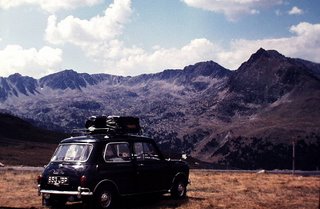
You can see from this picture that it is a wonderful place for walking and breathing in the good mountain air. In winter there is good skiing in Andorra.
And there is our first car; we loved that little Mini. Bill had it sprayed black with a dark green roof and it got lots of
admiring glances wherever we went.
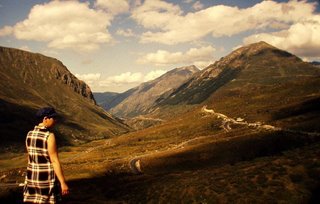
Here I am looking back down the valley into France.
Fortunately you can't see - but that dress was quite short. It was, after all the 1960s, when the mini skirt was the height of fashion. I am also sporting a trendy French peaked hat.
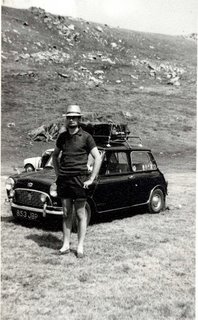
Bill looks sophisticated and trendy too, in his hat.
Maybe I can persuade him to have another straw hat next summer!
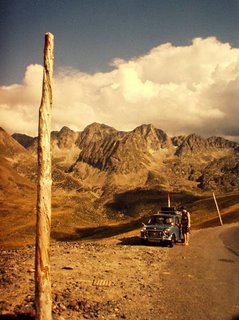
Another lovely view of the mountains.
In those days Bill didn't seem to mind having his pride and joy in the foreground - and he accepted having me alongside it too!
We have to accept that in those days we didn't venture far from the car.
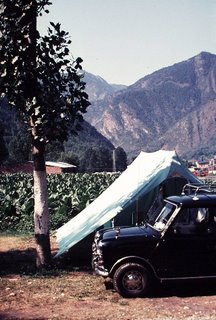
We dropped down into the main valley of Andorra and pitched our tent at a site just outside the main town of Andorra la Vella.
There is tobacco growing behind the tent.
We were glad the tent was in a higher part of the camp site, for there was an awful storm one night. We had to dig little trenches round the tent to take the rain water away - it flowed down to the lower part and flooded out other campers.
It is hard to believe that Andorra is part of a world that is almost 40 years away from us.
On such a day as this it seems apt that football should take centre stage in the world of sport.
The next big footballing championships have begun. In 2 years time we will enjoy the finals of the European Championships when the top 16 teams will battle for the trophy. At this stage, in each of the groups, some of the smallest countries take their places amongst the footballing giants.
I suppose that the separate counties of the United Kingdom may seem small, but in footballing terms each of them (England, Scotland, Wales and Northern Ireland) have had their moments of glory - and of course in 1966 England won the World Cup.
The "minnows" of Europe see these early stages as their own special moments.
And so earlier today we saw that the Faroe Islands - where Roger and Sue were just over a year ago, were well beaten by Scotland.
And this afternoon England scored 5 times against Andorra.
I expect that the players of these tiny countries have hoped that they might score a goal, but they also knew that defeat was their fate - although occasionally there have been footballing shocks of course.
But today results went much as expected - excepting for Wales who really should have beaten Iceland I guess.
Andorra is a tiny country set in The Pyrennees between France and Spain.
It flourishes as a centre for tourism and as a tax haven. It is a beautiful land and obviously suits people well for it has the highest life expectancy in the world of 83.51 years.
Bill and I have been there twice, in 1967 and 1968.
We were mere youngsters, not long married.
In those days we wanted to see everything during our 2 week holidays. We filled the car with camping equipment and drove each day from one camp site to another enjoying the countryside.
In our more mature years we rather like the idea of thoroughly absorbing a small area and look back on all the places we have been to without really remebering too much about what we have seen.
But Andorra was different. For a start we stayed there for longer.
In 1967 it was the furthest point that we reached.
The following year we stopped there en route for Spain.
The football match has caused us to think back - perhaps we should go back and spend some time finding out just what makes the country tick.

You can see from this picture that it is a wonderful place for walking and breathing in the good mountain air. In winter there is good skiing in Andorra.
And there is our first car; we loved that little Mini. Bill had it sprayed black with a dark green roof and it got lots of
admiring glances wherever we went.

Here I am looking back down the valley into France.
Fortunately you can't see - but that dress was quite short. It was, after all the 1960s, when the mini skirt was the height of fashion. I am also sporting a trendy French peaked hat.

Bill looks sophisticated and trendy too, in his hat.
Maybe I can persuade him to have another straw hat next summer!

Another lovely view of the mountains.
In those days Bill didn't seem to mind having his pride and joy in the foreground - and he accepted having me alongside it too!
We have to accept that in those days we didn't venture far from the car.

We dropped down into the main valley of Andorra and pitched our tent at a site just outside the main town of Andorra la Vella.
There is tobacco growing behind the tent.
We were glad the tent was in a higher part of the camp site, for there was an awful storm one night. We had to dig little trenches round the tent to take the rain water away - it flowed down to the lower part and flooded out other campers.
It is hard to believe that Andorra is part of a world that is almost 40 years away from us.
